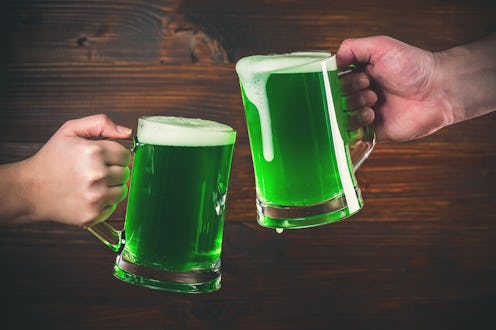St. Patrick’s Day is almost upon us, which means that many bars and pubs in the United States are already beginning to be taken over by…you guessed it… green beer. But what’s in green beer, exactly? You can probably guess the base ingredients — essentially, it’s just beer and food coloring — but it turns out that when it comes to mixing up a batch of green beer, the details of the ingredients matter a lot more than you might initially suspect.
The history of drinking green beer on St. Patrick’s Day — which seems to be a mostly American tradition (worth remembering: In Ireland, St.Patrick’s Day has historically been a religious observance, not a drinking holiday) — goes back about a century. The invention of the colorful drink is typically credited to Dr. Thomas Curtin, who added a colorant called Wash Blue (which, by the way, was not meant to be eaten) to a batch of beer and brought it to the Schnerer Club in New York in 1914. However, as Vox notes, a story actually appeared in the Spokane Press about a bar called the First Avenue Bar serving green beer on the holiday four years earlier than Dr. Curtin’s Schnerer Club escapades. “It is a regular beer, apparently it has not been colored locally, it tastes like beer and looks like paint, or rather like the deep green waves in mid-ocean with the sun striking them through,” reads the Spokane Press’ oddly poetic piece.
In any event, more than 100 years later, the tradition of drinking green beer on St. Patrick’s Day is still alive and well. So: What’s actually in your verdant beverage? Let’s take a look:
1Light-Colored Beer
When making green beer, the natural color of the brew really, really matters. As you might expect, beers that are light in color are your friends here; if the liquid is too dark, the green simply won’t be visible. Commonly suggested options include pale ales, pilsners, and regular ol’ light beers; I also suspect that options like wheat beers and blonde ales would work just fine, too. You’ll want to stay away from brown ales, porters, stouts, and other dark-colored beers; while some of them might theoretically work, sites like WikiHow warn that you’d need so much dye to turn them green that you might end up dying your own teeth green, too.
2Food Coloring
Not just any old option will do, however. Liquid food coloring is preferably, apparently; WikiHow notes that it will “mix with the beer much more easily” than gel food coloring will. The precise amount to use varies by recipe, but typically, either three to five or four to six drops is cited as the right amount.
Also, although it’s sometimes suggested that blue food coloring will do the trick — the idea being that when the blue dye mixes with a yellow-tinged beer, it’ll turn the mixture green — that may not actually be the case. According to both WikiHow and Betty Crocker, using blue food coloring will actually yield a drink that’s closer to turquoise than to green.
3Or, Alternatively, Spirulina
While it’s true that the green beer most pubs and bars sell on St. Patrick’s Day is of the “food coloring added” variety, Food & Wine reports that a few breweries have toyed around with brewing actual green beers. In 2006, for example, Delaware favorite Dogfish Head released Verdi Verdi Good as a brewhouse exclusive; a Dortmunder, it was a bright green brew with “a classic clean character” and “notes of biscuity malts.” Meanwhile, New York brewery Captain Lawrence unleashed Gimmicky Green Ale on the world in 2013, while San Antonio’s Freetail Brewing has a beer in its lineup called Spirulina Wit. Chinese brewery Tsintao also makes a green beer simply called Green Beer; the same is true for Japanese brewery Abishiri, which puts out an offering called Shiretoko Draft.
All of these beers use spirulina for the coloring. A type of blue-green algae, it lends a green tint to the drinks — and hey, if you’ve got access to it, you can even forego the standard food coloring and make your own spirulina green beer at home, too. According to Organic Authority, adding a quarter to a half a teaspoon of spirulina powder to your beer will turn it a lovely shade of green.
4Or Even Some Of THESE Ingredients
It’s less common to find green beer made with wheatgrass, matcha, squid ink, or straight-up chlorophyll (yes, the stuff that makes leaves green), but according to TIME, they do exist.Some of them work better than others; for example, Darren Robinson of Doctor’s Orders Brewing in Australia said to TIME that the squid ink used in the brewery’s Cephalopod Black Berliner Weisse didn’t change the taste of the beer at all — but it did result in quite a bit of inconsistency in terms of the color: Some batches were “radioactive green,” while others ended up “dirty paint-water grey.” But they’re still, y’know, options. Just sayin’.
No matter what you use to turn your beer green, though, if you’re making it at home, make sure you abide by two essential rules: First,add the food coloring to your glass before you pour in the beer; then, don’t stir it once you’ve combined the ingredients. If you do, you’ll make the beer go flat. And that would be very sad, indeed.
